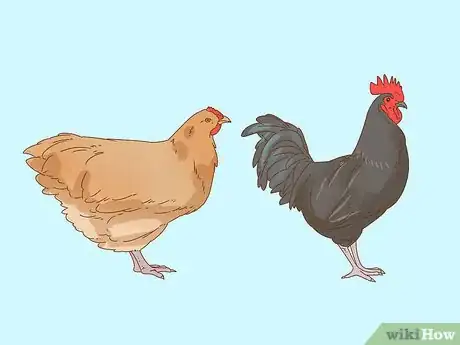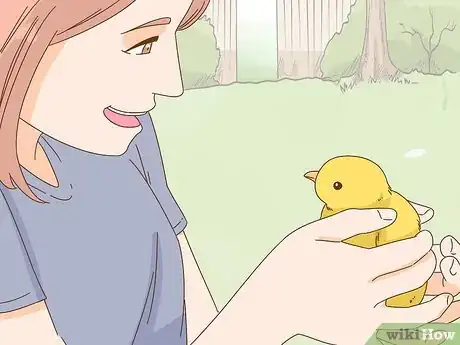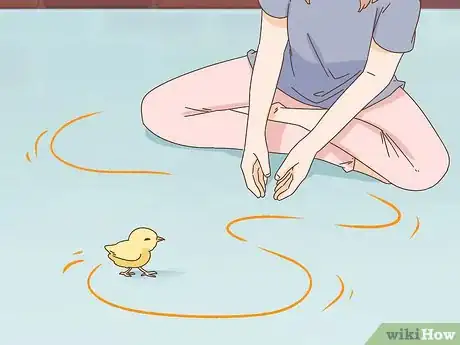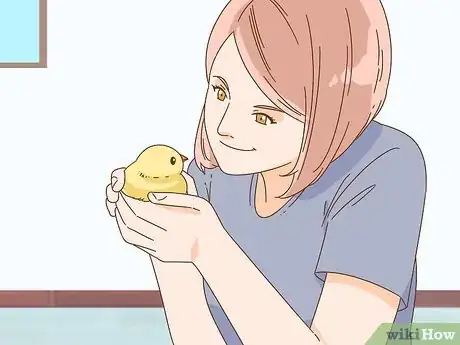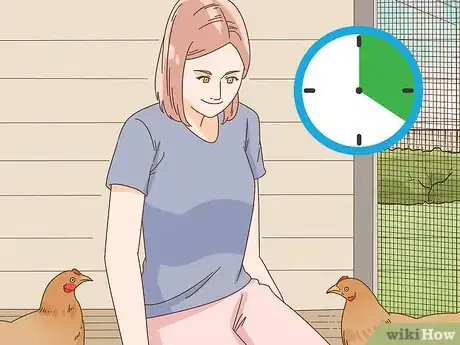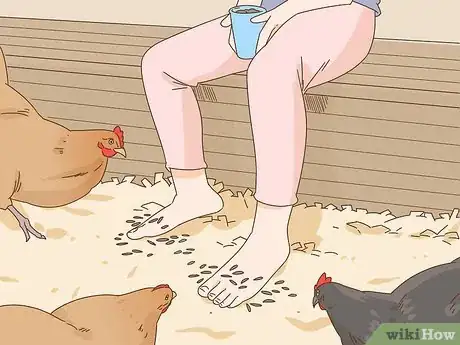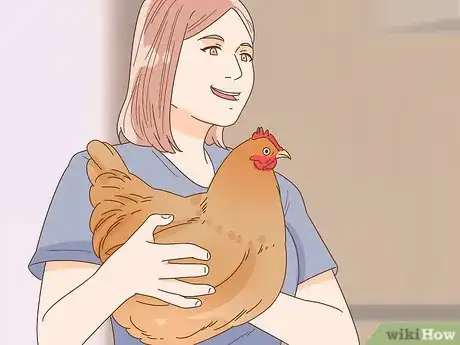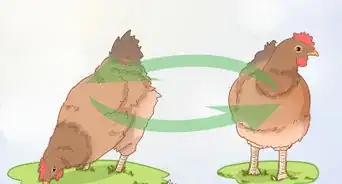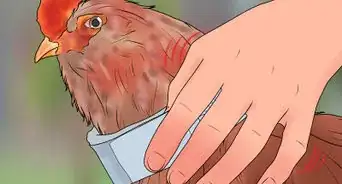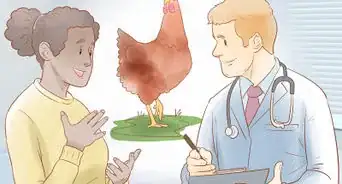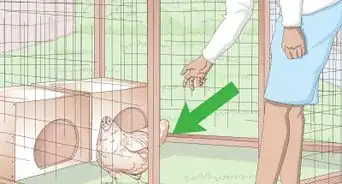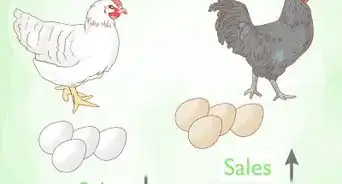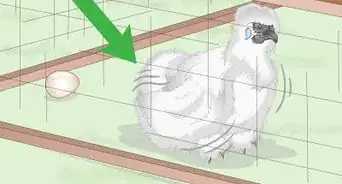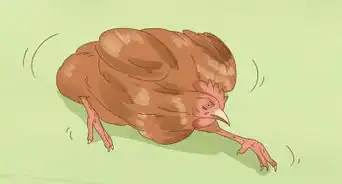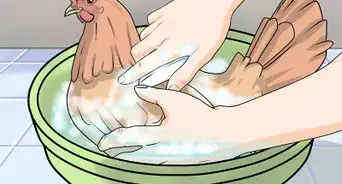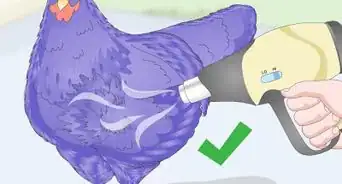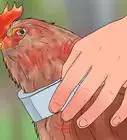This article was co-authored by wikiHow Staff. Our trained team of editors and researchers validate articles for accuracy and comprehensiveness. wikiHow's Content Management Team carefully monitors the work from our editorial staff to ensure that each article is backed by trusted research and meets our high quality standards.
wikiHow marks an article as reader-approved once it receives enough positive feedback. In this case, 92% of readers who voted found the article helpful, earning it our reader-approved status.
This article has been viewed 41,472 times.
Learn more...
You may think of chickens more as farm animals raised for eggs than as tameable pets, but with a little patience and love, they can be both! The easiest way to tame a chicken is to start handling it when it is a chick right after you bring it home from a breeder, but with a little work, you can tame older chickens as well. As with more common pets like dogs and cats, the way to a chicken’s heart is through food. Spend time with your chickens and feed them plenty of treats from your hand, and over time they will become tame and will love you. Check out the tips below to learn how you can tame a chicken so that it loves being handled and hand-fed.
Steps
Raising Baby Chicks to be Tame
-
1Choose a breed of chickens known for being friendly. There are many different breeds of chickens and some of them are easier to tame and handle. These breeds include Orpington, Black Australorp, Silke, Faverolle, Barred Rock, Sussex, Cochin, Easter Egger, Brahma, Wyandotte, and Buckeye.[1]
- The Orpington breed is known to be especially friendly.
-
2Start socializing with the chicks in the first week after you get them. Speak to them softly and gently so that they get used to your voice. Gently pick them up and hold them every day so that they will become accustomed to your touch.[2]
- Don’t start handling your chicks on the first day that you bring them home. Give them a day or two to adjust to their new home and get settled in.
- It’s normal for the chicks to scatter when you reach into their pen to grab them. Move your hand slowly and talk to them quietly so they understand that your hand is not a predator.
Tip: Chickens can be tamed using many of the same methods you would use to train a dog or a cat. They might not appreciate petting and cuddling the same way a dog or cat does, but it’s possible to tame a chicken to be very affectionate and friendly towards you!
Advertisement -
3Feed the chicks treats from your hand. Use treats like mealworms, sunflower seeds, oats, and raisins. Lower your hand into the chicks’ pen and hold it there steadily until they start walking up to eat out of it.
- Like many animals, the quickest way to tame your chicks is to get them to associate you and your hands with food.
- Once the chicks start eating out of your hand comfortably, then you can start using your index and middle fingers of the other hand to gently stroke their heads and backs while they eat.
-
4Let the chicks run around in an enclosed space after a week. Take the chicks out of their brooding pen and place them in a safe enclosed area of your home or an outdoor enclosure where they can’t escape. Sit on the ground with them and let them run around to explore and climb over you.[3]
- If you do this in your home, make sure to put down an old sheet to protect your floors from accidents!
- This is another good time to hand feed your chicks so they keep associating you with treats.
-
5Keep handling, hand feeding, and spending time with the chicks as they grow up. Chicks grow fast, and without constant bonding time they will easily revert to being wild chickens. Keep picking up, petting, cuddling, talking to, and giving treats to the chicks during the 2-3 months it takes them to develop fully so you will have a tame flock.[4]
- When the chicks are 3-7 weeks old, they may start acting more hyper, and seem less interested in you. During this time, hand feeding will be your most successful way to interact with them and keep them interested in you.
Taming Older Chickens
-
1Sit with your chickens in their coop for at least 20 minutes a day. Sit quietly and calmly in a chair or another seat in the chickens’ coop so they get used to you. Don’t make any sudden movements or loud sounds that will startle the flock.[5]
- It’s best to do this at a quiet time in the chickens’ routines, such as the late afternoon. If you go first thing in the morning, the chickens will be distracted looking for bugs to eat right after they wake up.
-
2Throw treats on the ground by your feet and talk to the chickens as they eat. Keep a cup full of treats like raisins, seeds, oats, or mealworms in your lap. Scatter some around your feet and gently talk to the chickens as they come over to investigate so they get used to your voice.
- Don’t try to touch or grab the chickens until they are completely comfortable eating from the ground around you.
-
3Give the chickens treats from your hand after they come over to you. Start offering the chickens treats by placing a few in your hand and lowering it to the height of their heads. Keep speaking to them softly as they eat from your hand.[6]
- You can alternate between scattering treats on the ground and offering them in your hand, if the chickens still seem nervous, until they get used to it and are confidently eating from your hand.
-
4Start petting the chickens with your free hand when they are eating from your hand. Stroke the feathers on their backs gently. Keep doing this every day until they are comfortable with you touching them.[7]
- You can try placing a couple raisins or grapes on your lap to see if the chickens will voluntarily jump up and eat out of your lap as you are hand feeding and petting them.
-
5Try picking up a chicken when they are comfortable with you touching them. Wrap both hands around the chicken’s wings and place your thumbs over the tops of its wings. Carefully lift the chicken up to your lap and give them a treat like a grape or raisin.[8]
- Remember that all chickens are different. Naturally, some chickens will never take to being handled by you, while others might be born cuddlers who enjoy sitting in your lap. Be patient and keep spending time with the flock to tame your older chickens.
Tip: Chicken breeds that are known to be easier to tame and more friendly are: Orpington, Black Australorp, Silke, Faverolle, Barred Rock, Sussex, Cochin, Easter Egger, Brahma, Wyandotte, and Buckeye.
Warnings
- Always wash your hands thoroughly with soap and water before and after handling chicks and chickens.⧼thumbs_response⧽
References
- ↑ https://www.backyardchickens.com/articles/how-to-tame-chickens-from-the-start.67246/
- ↑ https://www.backyardchickens.com/articles/how-to-tame-chickens-from-the-start.67246/
- ↑ https://www.backyardchickens.com/articles/how-to-tame-chickens-from-the-start.67246/
- ↑ https://www.backyardchickens.com/articles/how-to-tame-chickens-from-the-start.67246/
- ↑ https://www.tillysnest.com/2011/11/how-to-train-chicken-html/
- ↑ https://www.tillysnest.com/2011/11/how-to-train-chicken-html/
- ↑ https://www.tillysnest.com/2011/11/how-to-train-chicken-html/
- ↑ https://www.tillysnest.com/2011/11/how-to-train-chicken-html/
